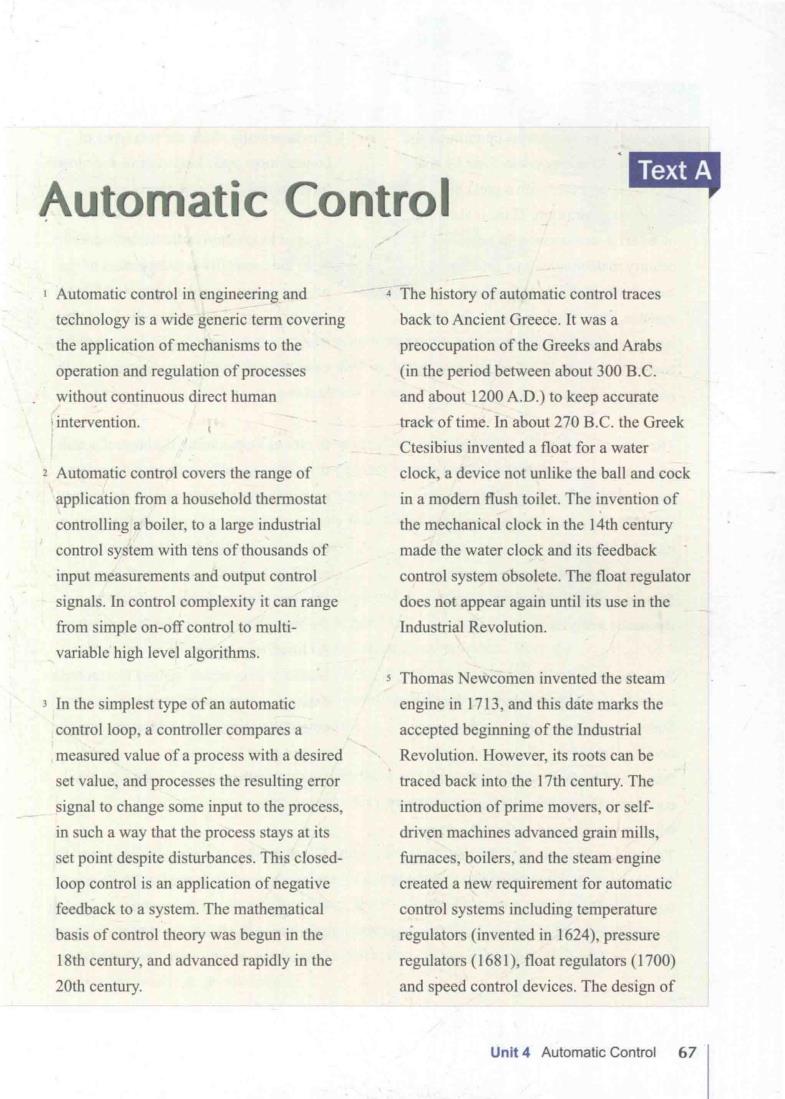正在加载图片...

Text A Automatic Control Automatic control in engineering and The history of automatic control traces technology is a wide generic term covering back to Ancient Greece.It was a the application of mechanisms to the preoccupation of the Greeks and Arabs operation and regulation of processes (in the period between about 300 B.C. without continuous direct human and about 1200 A.D.)to keep accurate intervention. track of time.In about 270 B.C.the Greek Ctesibius invented a float for a water 2 Automatic control covers the range of clock,a device not unlike the ball and cock application from a household thermostat in a modern flush toilet.The invention of controlling a boiler,to a large industrial the mechanical clock in the 14th century control system with tens of thousands of made the water clock and its feedback input measurements and output control control system obsolete.The float regulator signals.In control complexity it can range does not appear again until its use in the from simple on-off control to multi- Industrial Revolution variable high level algorithms. s Thomas Newcomen invented the steam In the simplest type of an automatic engine in 1713,and this date marks the control loop,a controller compares a accepted beginning of the Industrial measured value of a process with a desired Revolution.However,its roots can be set value,and processes the resulting error traced back into the 17th century.The signal to change some input to the process, introduction of prime movers,or self- in such a way that the process stays at its driven machines advanced grain mills set point despite disturbances.This closed- furnaces,boilers,and the steam engine loop control is an application of negative created a new requirement for automatic feedback to a system.The mathematical control systems including temperature basis of control theory was begun in the regulators(invented in 1624),pressure 18th century,and advanced rapidly in the regulators(1681).float regulators (1700) 20th century. and speed control devices.The design of Unit 4 Automatic Control 67Automatic Control ,, , 1 Automatic control in engineering and technology is a wide generic term covering the application of mechanisms to the operation and re lation of processes without continuous direct human 1 intervention . 2 Automatic control covers the range of application from a household thermostat con oiling a boiler, to a large industrial control system with tens of thousands of input measurements and output control signals. In con ol complexity it can range from simple on-off con ol to multivariable high level algorit 3 In the simplest type of an automatic control loop, a controller compares a measured value of a process with a desired set value, and processes the resulting error signal to change some input to the process, in such a way that the process stays at its set point despite disturbances. This closedloop control is an application of negative feedback to a system. The mathematical basis of control theory was begun in the 18th century, and advanced rapidly in the 20th century. - 4 The history of automatic control traces back to Ancient Greece. It was a preoccupation of the Greeks and Arabs (in the period between about 300 B.C. and about 1200 A.O.) to keep accurate track of time . In about 270 B.C. the Greek Ctesibius invented a float for a water clock, a device not unlike the ball and cock in a modem flush toilet. The invention of the mechanical clock in the 14th century made the water clock and its feedback control system obsolete. The float regulator does not appear again until its use in the Industrial Revolution. s Thomas Newcomen invented the steam engine in 1713, and this date marks the accepted beginning of the Industrial Revolution. However, its roots can be traced back into the 17th century. The introduction of prime movers, or selfdriven machines advanced grain mills, furnaces, boilers, and the steam engine created a new requirement for automatic control systems including temperature regulators (invented in 1624), pressure regulators (1681), float regulators (1700) and speed control devices. The design of Unit 4 Automatic Control 6 7